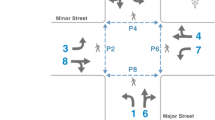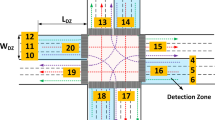Abstract
Traffic Circles are frequently used in cities, to control vehicular traffic at intersections. As said in [1], their main advantages can be the provision of an adequate throughput and the improvement of user safety, by slower vehicle speeds and reducing traffic conflicts.
Preview
Unable to display preview. Download preview PDF.
Similar content being viewed by others
References
Hossain, M.: Capacity estimation of traffic circles under mixed traffic conditions using micro-simulation technique. Transportation Research Part A: Policy and Practice (1999)
Sánchez, J., Galán, M., Rubio, E.: Genetic Algorithms and Cellular Automata: A New Architecture for Traffic Light Cycles Optimization. In: Proceedings of The Congress on Evolutionary Computation 2004 (CEC 2004), vol. 2, pp. 1668–1674 (2004)
Sánchez, J., Galán, M., Rubio, E.: Bit Level Versus Gene Level Crossover in a Traffic Modeling Environment. In: Proceedings of the International Conference on Computational Intelligence for Modelling Control and Automation - CIMCA 2005, vol. I, pp. 1190–1195 (2005)
Sánchez, J., Galán, M., Rubio, E.: Stochastic vs deterministic traffic simulator. Comparative study for its use within a traffic light cycles optimization architecture. In: Mira, J., Álvarez, J.R. (eds.) IWINAC 2005. LNCS, vol. 3562, pp. 622–631. Springer, Heidelberg (2005)
Sánchez, J.J., Galán, M.J., Rubio, E.: A visual and statistical study of a real world traffic optimization problem. In: Topping, B.H.V., Montero, G., Montenegro, R. (eds.) Proceedings of the Fifth International Conference on Engineering Computational Technology, Stirlingshire, United Kingdom, paper 147. Civil-Comp Press (2006)
Sánchez, J.J., Galán, M.J., Rubio, E.: Study of Correlation Among Several Traffic Parameters Using Evolutionary Algorithms: Traffic Flow, Greenhouse Emissions and Network Occupancy. In: Moreno Díaz, R., Pichler, F., Quesada Arencibia, A. (eds.) EUROCAST 2007. LNCS, vol. 4739, pp. 1134–1141. Springer, Heidelberg (2007)
Sánchez, J.J., Galán, M.J., Rubio, E.: Applying a traffic lights evolutionary optimization technique to a real case: “las ramblas” area in santa cruz de tenerife. IEEE Transactions on Evolutionary Computation (2008)
Sanchez-Medina, J.J., Galán, M.J., de Ugarte, N.A., Rubio, E.: Simulation times vs. network size in a genetic algorithm based urban traffic optimization architecture. In: GEM, pp. 255–261 (2008)
Benjaafar, S., Dooley, K., Setyawan, W.: Cellular Automata for Traffic Flow Modeling. Technical Report CTS 97-09, Intelligent Transportation Systems Institute (1997)
Nagel, K., Schleicher, A.: Microscopic traffic modeling on parallel high performance computers. Parallel Comput. 20(1), 125–146 (1994)
Cremer, M., Ludwig, J.: A fast simulation model for traffic flow on the basis of Boolean operations. Mathematics and Computers in Simulation (28), 297–303 (1986)
Krauss, S., Wagner, P., Gawron, C.: Metastable states in a microscopic model of traffic flow. Phys. Rev. E 55, 5597–5605 (1997)
Schadschneider, A., Chowdhury, D., Brockfeld, E., Klauck, K., Santen, L., Zittartz, J.: A new cellular automata model for city traffic. In: Traffic and Granular Flow 1999: Social, Traffic, and Granular Dynamics. Springer, Heidelberg (1999)
Nagel, K., Schreckenberg, M.: A Cellular Automaton Model for Freeway Traffic. Journal de Physique I France 2(33), 2221–2229 (1992)
Biham, O., Middleton, A.A., Levine, D.: Self-organization and a dynamical transition in traffic-flow models. Phys. Rev. A 46(10), R6124–R6127 (1992)
Brockfeld, E., Kühne, R., Skabardonis, A., Wagner, P.: Towards Benchmarking Microscopic Traffic Flow Models. Transportation Research Record (1852), 124–129 (2003)
Author information
Authors and Affiliations
Editor information
Editors and Affiliations
Rights and permissions
Copyright information
© 2009 Springer-Verlag Berlin Heidelberg
About this paper
Cite this paper
Sánchez Medina, J.J., Galán Moreno, M.J., Díaz Cabrera, M., Rubio Royo, E. (2009). Traffic Signals in Traffic Circles: Simulation and Optimization Based Efficiency Study. In: Moreno-Díaz, R., Pichler, F., Quesada-Arencibia, A. (eds) Computer Aided Systems Theory - EUROCAST 2009. EUROCAST 2009. Lecture Notes in Computer Science, vol 5717. Springer, Berlin, Heidelberg. https://doi.org/10.1007/978-3-642-04772-5_59
Download citation
DOI: https://doi.org/10.1007/978-3-642-04772-5_59
Publisher Name: Springer, Berlin, Heidelberg
Print ISBN: 978-3-642-04771-8
Online ISBN: 978-3-642-04772-5
eBook Packages: Computer ScienceComputer Science (R0)




